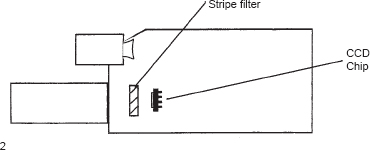Encoding combines many signals into one
Composite Encoding
The process of combining the three color signals is called encoding. The encoded signal, now called a composite signal, actually comprises two parts — the chroma (color) signal and the luminance (brightness) signal. Although there is some variation, the separate luminance signal is formed by skimming brightness information from each of the three CCDs. It is then recombined with the chroma signal to create the composite signal. If you had only a black and white TV, you would receive and watch only the luminance signal. The encoded, composite signal is fed out the back of the camera. The color TV has a decoder built in to re-create the three separate R, G, B signals.
Home Video Cameras
Note that some color home video cameras use only one chip instead of three. These chips have a filter of colored stripes in front of them. This striped filter breaks up the light into the three primary colors. Circuitry in the camera then combines these stripes of color into a composite color picture. As a result of this process, these cameras seldom approach broadcast quality. They rarely have the picture sharpness or color saturation needed for professional work. Even home video cameras that have three chips are of poorer quality than professional cameras. The chips they use have fewer pixels and are not of the same quality as those used in professional cameras.
1. Encoding.
2. Color home video camera.


